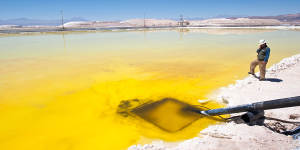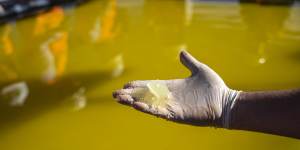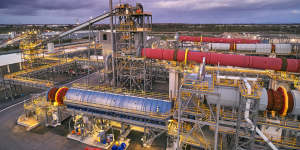With resources nationalism rising throughout the developed and developing worlds,that investment has proved riskier than it might have imagined.
Late last week,the company in which it invested,Chile’s SQM – the world’s second-largest lithium producer –,under which its lithium assets will be transferred to a joint venture. Codelco will own 50 per cent plus one share of the new vehicle.

Evaporation ponds in the Atacama Desert,Chile. The sun evaporates the water,leaving lithium chloride.Alamy
Codelco’s involvement in lithium came after Chile’s president,Gabriel Boric,announced plans to nationalise the lithium industry last year to boost the economy and protect Chile’s environment. Private companies would have to partner with the state if they wanted to mine for lithium in Chile.
SQM may have had no choice but to accede to the pressure to partner with Codelco,given that its concession to mine the vast Atacama salt flats is set to expire in 2030.
The new joint venture will complete SQM’s contracts with Chile’s government mining agency Corfo through to 2030,but will then get an extension of the concession until 2060,along with a significant increase in the production quota within the contracts.
Tianqi,which may have hoped to gain control of SQM when it originally acquired its shareholding,is understandably displeased by events. Its exposure to SQM’s lithium operations – which generated $US315 million of dividends for it last year – will be heavily diluted and become indirect.
SQM has resisted Tianqi’s calls for a shareholders’ meeting to vote on the deal,saying the agreement requires only board approval. Tianqi has sought a ruling from Chile’s securities regulator on whether a shareholder vote is required and has also threatened legal action.
If the joint venture were thwarted,SQM’s concession would end in 2030 with no certainty that it would be renewed – it could be left with no right to mine in the Atacama desert. The Chilean government has the ultimate leverage to force through the deal.
When Tianqi bought into SQM,its purchase was consistent with a decade-long plan by China’s strategists to dominate the critical minerals essential to electric vehicle production,an industry it had also earmarked for domination. Those goals have been a key feature of China’s five-year plans over the past decade and a half.

Traces of lithium concentrate at a lithium mine in the Atacama Desert,Chile.Bloomberg
The strategy,backed by an estimated $US100 billion or so of subsidies,rebates and tax concessions,has succeeded.
China now dominates the processing of most of the critical minerals needed for electric cars and other green technologies such as solar cells.
In lithium,despite having less than 8 per cent of the world’s reserves,China has a roughly 80 per cent share of its processing. To support that position and secure supplies of the raw material,Chinese companies – and Tianqi has been at the forefront – have taken up myriad equity positions in lithium miners.
In Australia,which but has exported more than 90 per cent of it to China for processing,Tianqi owns 51 per cent of the Greenbushes mine,the world’s largest hard rock lithium mine. It also in Western Australia.
Other Chinese companies have been active here,but they have also been acquiring stakes in mines in Latin America and Africa.

Strategic investment:Tianqi’s lithium hydroxide plant at Kwinana.
The impact of the pandemic on global supply chains highlighted the world’s dependence on China for a lot of products,not the least of which was critical minerals and metals at a time when geopolitical tensions between China and the US were rising rapidly.
A key objective of the is to reduce America’s reliance on China for both critical minerals and their end products,lithium-ion batteries and solar cells in particular.
There are significant incentives for companies to source and/or process lithium from non-Chinese or Chinese-influenced sources. Wesfarmers’ and SQM’s $2.6 billion Mt Holland mine and processing plant in WA might,along with other miners that don’t have big Chinese shareholders,benefit from the US incentives.
The Albanese government’s is also providing hundreds of millions of dollars of incentives to encourage onshore processing of lithium even as it has toughened up restrictions on investments by Chinese companies in Australian critical minerals projects and companies.
The Federal Government has laid out labor's plan for Australia's future unveiling a streamlined investment strategy to boost local manufacturing.
The efforts by the US and its allies to reduce their reliance on China for the raw materials of a green economy,driven by national and economic security concerns,are coinciding with an outbreak of resources nationalism in the developing economies.
Indonesia famously emerged as the world’s largest nickel producer after it banned exports of the raw material,forcing mainly Chinese companies to process the metal within Indonesia.
Zimbabwe banned the exporting of unprocessed lithium in 2022 to force local processing. Namibia has done the same. Last year,Mexico decreed that its lithium reserves would be nationalised. Bolivia has torn up agreements between its state-owned lithium producer and foreign companies.
Chile,Argentina and Bolivia (which has about 20 per cent of the world’s lithium reserves) have been talking about joining forces to exploit their so-called “lithium triangle” to form an OPEC-like lithium cartel.
With governments around the world taking back control of critical minerals resources or restricting China’s access to them,China’s ability to secure its supplies of raw materials is to some extent being threatened,along with the value of the direct and indirect interests that its companies,such as Tianqi,have accumulated.
The reality that China dominates the processing of critical minerals and manufacturing of products such as batteries and solar cells,but also has the leading-edge technologies for most of the critical green economy products,insulates it to some degree from the actions being taken by the US,its allies and some developing economies.
It might face reduced security of supply and increased costs for the raw materials that power its green tech companies,and it might face greater competition in batteries and solar cells. But the extent of its dominance,and the abundance of the critical minerals that support it,push any material threats to its position well into the future.
Read more:
The Business Briefing newsletter delivers major stories,exclusive coverage and expert opinion..